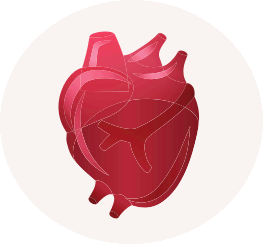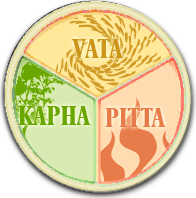![Circulation (Vyana vayu) Ayurveda]() Categories in Blood and CirculationTemperature SignsWater RegulationCirculationHeartLymph / Blood PlasmaRed Blood CellsImmune-SystemLiver & GallbladderAround EyesEyesTongue CoatingTongue Surface / CracksTongue BodyPulseOverview
Don't know your body type? Take our free Dosha quiz!
TAKE THE QUIZ
40 likes ![Save this Symptom. Save this Symptom]() SAVE SYMPTOM SAVE SYMPTOMSensitivity to heat indicates various patterns of imbalance. Sometimes the body becomes hot when deficient (as in dry eczema, or yin-deficient heat of Chinese medicine). Otherwise, heat may come from some kind of internal inflammation. A fever is a...
17 likes ![Save this Symptom. Save this Symptom]() SAVE SYMPTOM SAVE SYMPTOMWhen you feel hot in your torso area, but also have cold extremities, it can indicate poor circulation and overcompensation by the heart. Sweet, thick Kapha blood is the likely culprit.
35 likes ![Save this Symptom. Save this Symptom]() SAVE SYMPTOM SAVE SYMPTOMBurning feet syndrome is characterized by severe burning and aching feet. There may also be pain, elevated skin temperature, and excessive sweating.Burning feet syndrome may be a symptom of another disease, such as hypothyroidism, diabetes,...
32 likes ![Save this Symptom. Save this Symptom]() SAVE SYMPTOM SAVE SYMPTOMA person may flush easily when they are overheated, experience intense emotions, due to toxicity or hormone fluctuations, or after indulging in Pitta aggravating foods or lifestyle. Intense emotions can trigger an increase in the heart rate or...
22 likes ![Save this Symptom. Save this Symptom]() SAVE SYMPTOM SAVE SYMPTOMDermatographism, the ability to 'draw' on the skin, is a sign of capillary vasodilation due to Pitta type toxicity. It may indicate lymphatic stagnation as well.
11 likes ![Save this Symptom. Save this Symptom]() SAVE SYMPTOM SAVE SYMPTOMCapillary fragility and increased blood pressure can cause capillaries to become distended and visible in the skin. As a person ages, the capillaries become more fragile. Alcoholism, smoking, and cardiovascular diseases can increase blood pressure....
![]()
ENZYME DEFICIENCIES
FREE PRESENTATION
IMPROVE ENZYME OUTPUT & MASTER YOUR DIGESTION
GET IT NOW FREE
57 likes ![Save this Symptom. Save this Symptom]() SAVE SYMPTOM SAVE SYMPTOMKapha people become cold when metabolism is low or circulation is poor (Kapha). Vata people are cold when the skin is too dry, there is a lack of adequate fat tissue in the skin, or blood sugar levels are low. Pitta people feel cold when they radiate...
65 likes ![Save this Symptom. Save this Symptom]() SAVE SYMPTOM SAVE SYMPTOMCold extremities can imply a blood deficiency such as anemia, poor circulation from dehydration or congestion, a low metabolism, low blood sugar levels, insufficient clothing or fat, or stress. A chronic infection such as candida can rob the body of...
12 likes ![Save this Symptom. Save this Symptom]() SAVE SYMPTOM SAVE SYMPTOMBlue skin is a sign of blood stagnation due to coldness or dryness.
34 likes ![Save this Symptom. Save this Symptom]() SAVE SYMPTOM SAVE SYMPTOMLeg cramps generally comes from poor circulation, toxicity, or imbalance in electrolytes. Cholesterol medication can cause a cramp as well. There is a colon marma or acupressure point where the two heads of the gastrocnemius muscle meet. This point may...
16 likes ![Save this Symptom. Save this Symptom]() SAVE SYMPTOM SAVE SYMPTOMBlue nail-beds signify stagnant blood, which may be due to poor circulation or low blood pressure.
16 likes ![Save this Symptom. Save this Symptom]() SAVE SYMPTOM SAVE SYMPTOMA blue / purple tongue indicates internal blood stagnation (Kapha) or cold quality (Vata).
8 likes ![Save this Symptom. Save this Symptom]() SAVE SYMPTOM SAVE SYMPTOMSeen as a sign of high cholesterol or low thyroid.
![]()
AYURVEDIC FACE ASSESSMENT
FREE PRESENTATION!
Learn how to assess constitution by a person's face.
GET IT NOW FREE
89 likes ![Save this Symptom. Save this Symptom]() SAVE SYMPTOM SAVE SYMPTOMThe skin around your eye area is the thinnest and most fragile skin found on the entire body. As you age, the lids under the eye may swell with fluids or fats. Muscles and ligaments responsible for holding those fats in place may become lax. Since the...
38 likes ![Save this Symptom. Save this Symptom]() SAVE SYMPTOM SAVE SYMPTOMTingling / numbness could result from poor circulation or other problems. A limb may be numb due to nerve pathology. Circulation may be blocked because of sweet, thick Kapha blood, bloating in the digestive tract, fat tissue, edematic swelling, and...
31 likes ![Save this Symptom. Save this Symptom]() SAVE SYMPTOM SAVE SYMPTOMPins and needles are a sign of poor circulation. Circulation may be poor when the blood vessels are blocked by plaque, the blood is too thick, of the heart is not strong enough to pump the blood. Stress, cold body temperatures, a sedentary lifestyle,...
61 likes ![Save this Symptom. Save this Symptom]() SAVE SYMPTOM SAVE SYMPTOMShadows under the eyes imply Vata type ama in the colon or gall bladder stagnation.
9 likes ![Save this Symptom. Save this Symptom]() SAVE SYMPTOM SAVE SYMPTOMFeeling pain less than other people, or hypoalgesia, is a condition in which there is decreased sensitivity to painful stimuli. Hypoalgesia is a potentially dangerous condition as there may be a reduced or delayed response in processing painful...
14 likes ![Save this Symptom. Save this Symptom]() SAVE SYMPTOM SAVE SYMPTOMFeeling pain more than other people, or hyperalgesia, is a condition in which there is increased sensitivity to painful stimuli. Pain is detected by sensory nerves. If you feel pain more than others, the nervous system is likely agitated or on high...
7 likes ![Save this Symptom. Save this Symptom]() SAVE SYMPTOM SAVE SYMPTOMPoor discernment of temperature is the inability to distinguish sensations of hot and cold. Inadequate circulation to peripheral nerves in the skin causes poor discernment of temperature.Your peripheral nervous system requires fresh blood and ample...
47 likes ![Save this Symptom. Save this Symptom]() SAVE SYMPTOM SAVE SYMPTOMBruising easily is a sign of high Pitta in Ayurveda. Capillary beds may be dilated due to a heat condition in heart or liver, general inflammation, or irritating toxins in the blood. Platelet count may be low. Malabsorption of vitamins C and K may be a...
![]()
AYURVEDIC SPEECH ASSESSMENT
FREE PRESENTATION!
Learn how to assess constitution by a person's speech patterns.
GET IT NOW FREE
5 likes ![Save this Symptom. Save this Symptom]() SAVE SYMPTOM SAVE SYMPTOMIn Raynaud's, exposure to cold triggers the body to shunt blood from the hands and feet symmetrical and into the core, to prioritize vital organs. It is characterized by hyper-reactive vasoconstriction to cold.
As a result, the hands turn white...
7 likes ![Save this Symptom. Save this Symptom]() SAVE SYMPTOM SAVE SYMPTOMBleeding less than other people can be a good thing - it means you won't lose as much blood if you cut or injure yourself. If pathological, it could be due to either thick, viscous blood with sluggish circulation
3 likes ![Save this Symptom. Save this Symptom]() SAVE SYMPTOM SAVE SYMPTOMPainful clots may appear closer to the skin's surface (superficial thrombophlebitis). Or, a clot may be deep, such as deep vein thrombosis (DVT). DVT can cause the entire leg to swell and can be a life threatening complication. Many DVT are...
9 likes ![Save this Symptom. Save this Symptom]() SAVE SYMPTOM SAVE SYMPTOMA non-healing ulcer or diabetic sore is one that does not respond to initial treatment and persists despite appropriate care. Diabetic ulcers generally tend to develop on the legs and feet due to poor circulation or edema in the lower extremities....
3 likes ![Save this Symptom. Save this Symptom]() SAVE SYMPTOM SAVE SYMPTOMA stroke is a loss of blood flow to a part of the brain, occuring due to a clot or an aneurysm. A stroke caused by an aneurysm occurs when the the walls of an artery in the brain rupture. This happens when the artery wall has been weakened from...
11 likes ![Save this Symptom. Save this Symptom]() SAVE SYMPTOM SAVE SYMPTOMAn ischemic stroke is a loss of blood flow to a part of the brain, occuring due to a clot. This disruption in blood flow leads to the sudden death of brain cells. A clot can cause an obstruction in blood vessels inside the brain (thrombotic stroke), or...
![]()
IDENTIFY YOUR BODY
TYPE SAMPLE LECTURE!
LEARN HOW TO IDENTIFY YOUR BODY
TYPE WITH THIS 45-MINUTE SAMPLE
LECTURE FROM JOYFUL BELLY
GET IT NOW FREE
87 likes ![Save this Symptom. Save this Symptom]() SAVE SYMPTOM SAVE SYMPTOMIf you are prone to headaches and want a natural source of relief, you’ve come to the right place.
While there are many types of headaches, Ayurveda teaches that most are symptomatic of an imbalance in the blood.
Let’s explore some...
1 like ![Save this Symptom. Save this Symptom]() SAVE SYMPTOM SAVE SYMPTOMThe most common causes of blood vessels inflammation include:
Varicose veins
Long standing blood stasis
Trauma to the vessel
5 likes ![Save this Symptom. Save this Symptom]() SAVE SYMPTOM SAVE SYMPTOMA person that has difficulty clotting may bleed excessively from minor trauma, the GI tract, or in the brain. Under extreme conditions, even walking can cause bleeding and damage in internal organs.
Blood thinners, vitamin K antagonists,...
33 likes ![Save this Symptom. Save this Symptom]() SAVE SYMPTOM SAVE SYMPTOMRedness or flushed skin is generally a sign of heat and inflammation (Pitta). This internal heat may be due to fever, skin allergies, toxins from inflammatory processes, infection, or buildup of toxins in the skin.
Skin may also be flushed due to...
7 likes ![Save this Symptom. Save this Symptom]() SAVE SYMPTOM SAVE SYMPTOMPink skin appears predominantly pink in color. It can be a sign of strong, healthy circulation of blood to the surface of the skin.
However, in some cases, skin may appear pink if it is inflamed, irritated, or there is sun damage. Pink or inflamed...
17 likes ![Save this Symptom. Save this Symptom]() SAVE SYMPTOM SAVE SYMPTOMSweaty palms may create discomfort in social situation that require shaking hands. Palm sweat is increased when your circulatory system is congested, the blood toxic, when stressed, when you have a heat condition, or when excess fat blocks the release...
![]()
FIVE-DAY AYURVEDA CLEANSE
REMOVE TOXINS FROM YOUR BODY,
CREATE A HEALTHY ROUTINE & IMPROVE
YOUR DIGESTION IN JUST 5 DAYS.
GET IT NOW FREE
![ayurvedic diet]() 1 | 2 ![ayurvedic diet]() ![]() MORE BLOOD AND CIRCULATION TIPSDISCLAIMER: The pathogenesis of each person's condition is unique, and so the diet must be fit to the individual and the unique root causes of the condition in your body.
The information on this page is for educational purposes only and should not be used to treat a medical condition. It is not a substitute for medical care.
Please check with your doctor before making any changes to your health and wellness routine.
HOW AYURVEDA WORKS
ARE YOU WONDERING HOW AYURVEDA CAN HELP YOU?
WHY IS AYURVEDA THE RIGHT SOLUTION?
Ayurveda strengthens the body while opposing disorders. It takes a holistic,
systemic approach that looks at the whole body. Ayurveda
shows how to interpret signs and symptoms of imbalance, and how to address them
using diet, lifestyle adjustments, and herbs. It shows a person how to optimize their health on a continual basis. You can't
take the doctor home with you, but you can take Ayurveda home with you.
Ayurveda is the most advanced and easy to use home system for self healing.
HOW DOES AYURVEDA WORK?
Ayurveda starts by identifying your body type,
which identifies certain tendencies in your body to get sick (as well as identifying your strengths).
It uses body type to determine the likely root causes of your disorders.
Next, Ayurveda analyzes the nature of your disorder.
It fits all your signs and symptoms into a pattern, expressed as a combination of biocharaceristics (gunas).
For example, you may have a heat disorder, a cold disorder, or an oily disorder, etc.
This simple categorical approach shows you how to correct systemic imbalances and strengthen your body as a whole.
On Joyful Belly, we've created an extensive categorization of food so you can easily match food to your imbalanced biocharacteristics.
By eating an optimal diet that balances your biocharacteristics, your whole body is strengthened
and the conditions that created the disorder are removed. Once the root causes of the disease
are removed, the disease lessens in strength or disappears altogether. Additional remedies -
such as herbs and lifestyle practices - focused on the specific disorder, can greatly enhance
your healing.
GET STARTED
To get started on your Ayurvedic journey, we first recommend that your find your body
type by taking our free quiz. In Ayurveda, every solution is based on your unique body type, so
by taking this quiz, you’ll get the best results.
FIND YOUR BODY TYPE
Suggest a symptom |


 SAVE SYMPTOM
SAVE SYMPTOM SAVE SYMPTOM
SAVE SYMPTOM SAVE SYMPTOM
SAVE SYMPTOM SAVE SYMPTOM
SAVE SYMPTOM SAVE SYMPTOM
SAVE SYMPTOM



 (4.00 out of 5 stars) 1 rating, 22 likes
(4.00 out of 5 stars) 1 rating, 22 likes SAVE SYMPTOM
SAVE SYMPTOM SAVE SYMPTOM
SAVE SYMPTOM SAVE SYMPTOM
SAVE SYMPTOM



 (1.00 out of 5 stars) 1 rating, 25 likes
(1.00 out of 5 stars) 1 rating, 25 likes SAVE SYMPTOM
SAVE SYMPTOM SAVE SYMPTOM
SAVE SYMPTOM SAVE SYMPTOM
SAVE SYMPTOM SAVE SYMPTOM
SAVE SYMPTOM SAVE SYMPTOM
SAVE SYMPTOM


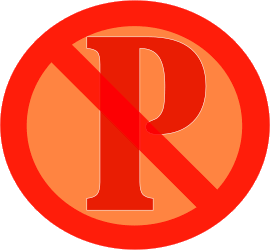

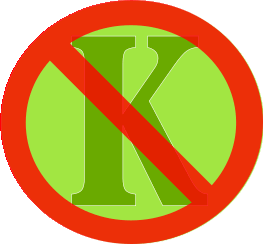


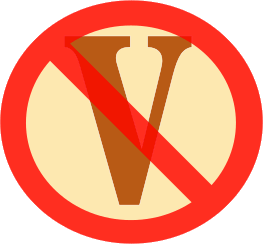



 1 |
1 | 
